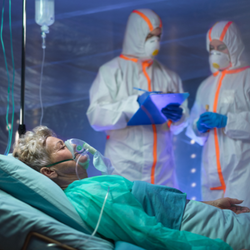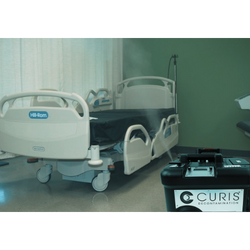A Deadly Combination: Fungus and COVID-19
Aspergillosis and Coronavirus:
 A correlation has been seen between hospitalized COVID-19 patients and cases of aspergillosis, so much so, that the combination of infections has been given its own terminology.1 The newly-named COVID-19-Associated Pulmonary Aspergillosis (CAPA) is a deadly fungal infection that can attack the lungs and cause a severe inflammatory response in COVID-19 patients. Many, but not all, patients who develop this hospital-acquired infection have pre-existing conditions such as COPD, heart disease, or diabetes.2 Additionally, steroids used to treat inflammation due to COVID-19 can reduce immune system response making the body more hospitable to fungal pathogens. Of the 20-30% of severely ill and mechanically ventilated COVID-19 patients with CAPA infections,3,4 most developed aspergillosis symptoms within nine days of admission to the intensive care unit (ICU).5 Development of CAPA has a mortality rate of approximately 33%,6 nearly twice the 17.1% mortality rate of hospitalized patients with COVID-19 alone.7
A correlation has been seen between hospitalized COVID-19 patients and cases of aspergillosis, so much so, that the combination of infections has been given its own terminology.1 The newly-named COVID-19-Associated Pulmonary Aspergillosis (CAPA) is a deadly fungal infection that can attack the lungs and cause a severe inflammatory response in COVID-19 patients. Many, but not all, patients who develop this hospital-acquired infection have pre-existing conditions such as COPD, heart disease, or diabetes.2 Additionally, steroids used to treat inflammation due to COVID-19 can reduce immune system response making the body more hospitable to fungal pathogens. Of the 20-30% of severely ill and mechanically ventilated COVID-19 patients with CAPA infections,3,4 most developed aspergillosis symptoms within nine days of admission to the intensive care unit (ICU).5 Development of CAPA has a mortality rate of approximately 33%,6 nearly twice the 17.1% mortality rate of hospitalized patients with COVID-19 alone.7
Mucormycosis and Coronavirus:
Similar to CAPA, ‘black fungus’ or mucormycosis is another fungal infection dangerous to COVID-19 patients with an extremely high mortality rate of 50%.8 Like CAPA, this infection can be influenced by pre-existing conditions and the heavy steroids that patients are given to reduce inflammation caused by COVID-19.9 The combination can be especially risky according to Dr. Atul Patel who found nearly 85% of mucormycosis patients with COVID-19 history also had uncontrolled blood sugar (a symptom or prelude to diabetes) and heavy steroid use.10 Diabetes patients are particularly at risk as fungi can feed on sugar imbalances in the body. Symptoms of mucormycosis usually occur between 12 to 15 days after recovery from COVID-19.8
Fungi are Opportunistic Pathogens
Both mucormycosis and aspergillus are opportunistic pathogens which prey on the weakened immune systems of their hosts. Treatment for both includes the use of anti-fungal medications, with some patients requiring surgery of the infected area. Understanding and preventing aspergillosis and mucormycosis are crucial steps to make ICUs and health care facilities safer for even the sickest patients.
Prevention
 Preventing the spread of fungal pathogens is crucial in protecting the most vulnerable among the patient population. Proper room disinfection protocols should be observed to mitigate the spread of infection upon patient discharge. In the case of this dangerous endemic infection a comprehensive fogging system may be helpful since the fog will infiltrate even the smallest crevices providing disinfectant throughout the room and its contents. Another consideration is that unfiltered ventilation systems can contribute to fungal spread, so tools such as HEPA filters should be used to improve air quality in the facility.11 Studies indicate that changing the air filter can cause spores to fall into a patient room, so sporicidal disinfection should follow filter changes.12 Dust from building renovation or construction can increase the risk of releasing spores into the air, and should be controlled.6,11
Preventing the spread of fungal pathogens is crucial in protecting the most vulnerable among the patient population. Proper room disinfection protocols should be observed to mitigate the spread of infection upon patient discharge. In the case of this dangerous endemic infection a comprehensive fogging system may be helpful since the fog will infiltrate even the smallest crevices providing disinfectant throughout the room and its contents. Another consideration is that unfiltered ventilation systems can contribute to fungal spread, so tools such as HEPA filters should be used to improve air quality in the facility.11 Studies indicate that changing the air filter can cause spores to fall into a patient room, so sporicidal disinfection should follow filter changes.12 Dust from building renovation or construction can increase the risk of releasing spores into the air, and should be controlled.6,11
Detection
Fungal spores can float in the air and, as a result, can be detected via an air sample test. This sampling can determine the presence of Aspergillus and other harmful aerosols. Air sampling should be conducted following a patient release or prior to admission of a new patient into the possibly contaminated room.
Outbreak Control
Once detected, hospitals must act fast to tackle the dangers of fungal infections. If there is suspicion of fungal spores being found in the ICU, air sampling should be collected immediately and protocols put in place to prevent further spread.13 Due to the large percentage of COVID-19 patients who become infected with aspergillosis, worsened respiratory distress could be a warning sign, as could one or more patients who occupied the same room testing positive for aspergillosis.12 In order to overcome environmental challenges, hospitals should use the resources at their disposal such as the CDC, WHO, and The Journal of Clinical Microbiology to learn more about these infections and seek professional guidance if a colony is detected.
Conclusion
Just as physician awareness of an association between severe influenza and fungal infections may have led to a rapid recognition of CAPA,3 the challenges we face during this pandemic provide learning experiences which can benefit the future. Understanding and preventing dangerous fungal infections experienced by COVID-19 patients will allow us to respond to microbiological threats in the future. Better understanding the presence and risk of fungal pathogens helps hospitals establish stronger infection control protocols in high-risk areas such as the ICU. These strategies are crucial for success during this and future public health emergencies.
References
- Lai CC, Yu WL. COVID-19 associated with pulmonary aspergillosis: A literature review. Journal of microbiology, immunology, and infection. 2020;54(1), 46–53. https://doi.org/10.1016/j.jmii.2020.09.004
- Vandewoude KH, Vogelaers D, Blot SI. Aspergillosis in the ICU – The new 21st century problem?. Medical Mycology. 2006:44(1) S71-S76.
https://doi.org/10.1080/13693780600919262 - Kuehn BM. Pulmonary Fungal Infections Affect Patients With COVID-19. 2020;324(22):2248. doi:10.1001/jama.2020.22914
- Alanio A, Dellière S, Fodil S, Bretagne S, Mégarbane B. Prevalence of putative invasive pulmonary aspergillosis in critically ill patients with COVID-19. Lancet Respir Med. 2020;8(6):e48-e49. doi:10.1016/S2213-2600(20)30237-X
- Marr KA, Platt A, Tornheim JA, Zhang SX, Datta K, Cardozo C, et al. Aspergillosis Complicating Severe Coronavirus Disease.Emerging Infectious Diseases. 2021;27(1), 18-25. https://doi.org/10.3201/eid2701.202896.
- Salmanton-García J, Sprute R, Stemler J, Bartoletti M, Dupont D, Valerio M, Garcia-Vidal C, et al. COVID-19-Associated Pulmonary Aspergillosis, March-August 2020. Emerg Infect Dis. 2021;27(4):1077-1086. doi: 10.3201/eid2704.204895. Epub 2021 Feb 4. PMID: 33539721; PMCID: PMC8007287.
- Macedo A, Gonçalves N, Febra C. COVID-19 fatality rates in hospitalized patients: systematic review and meta-analysis. Ann Epidemiol. 2021;57:14-21. doi:10.1016/j.annepidem.2021.02.012
- Biswas S. Mucormycosis: The 'Black Fungus' Maiming Covid Patients in India. BBC News. 9 May 2021, bbc.com/news/world-asia-india-57027829. (Accessed June 2021)
- Drissi C. Black fungus, the darker side of COVID-19. J Neuroradiol. 2021;48(5):317-318. doi:10.1016/j.neurad.2021.07.003
- Sharma R. Gujarat: Tsunami of Mucormycosis among Covid-19 Recovered: Ahmedabad News - Times of India. The Times of India. 6 May 2021, https://timesofindia.indiatimes.com/city/ahmedabad/tsunami-of-mucormycosis-among-covid-19-recovered/articleshow/82417159.cms (Accessed August 2021)
- Oren I, Haddad N, Finkelstein R, Rowe JM. Invasive pulmonary aspergillosis in neutropenic patients during hospital construction: before and after chemoprophylaxis and institution of HEPA filters. Am J Hematol. 2001;66(4):257-262. doi:10.1002/ajh.1054
- Pittet D, Huguenin T, Dharan S, Sztajzel-Boissard J, Ducel G, Thorens JB, Auckenthaler R, Chevrolet JC. Unusual cause of lethal pulmonary aspergillosis in patients with chronic obstructive pulmonary disease. Am J Respir Crit Care Med. 1996 Aug;154(2 Pt 1):541-4. doi: 10.1164/ajrccm.154.2.8756836. PMID: 8756836.
- Demuyser T, De Cock E, Sermijin E. Airborne Aspergillus Fumigatus Contamination in an Intensive Care Unit: Detection, Management and Control. Journal of Infection and Public Health. 2019;12(6) 904-906, ISSN 1876-0341, https://doi.org/10.1016/j.jiph.2019.04.016.
Additional Resources
“Information for Healthcare Professionals.” Centers for Disease Control and Prevention, Centers for Disease Control and Prevention, 23 Apr. 2021, www.cdc.gov/fungal/diseases/aspergillosis/health-professionals.html.